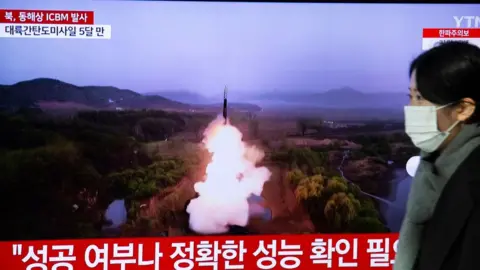North Korea fires most powerful long-range missile after South Korea-US meeting
 EPA
EPANorth Korea has fired its most advanced long-range missile, South Korean authorities say, defying UN curbs.
The launch of the intercontinental ballistic missile (ICBM) drew immediate condemnation from the West. It landed west of Hokkaido in Japan.
It comes after South Korean and US defence officials met last week to update plans on how to respond to a nuclear attack from the North.
Pyongyang had vowed to take "more offensive countermeasures" in response.
The isolated state launched the long-range missile on Monday morning about 08:24 local time (23:24 Sunday GMT) from the Pyongyang area.
South Korean and Japanese officials said the missile travelled for 73 minutes, covering about 1,000km (621 miles).
ICBMs have the range to reach the North American continent. Monday's launch is North Korea's fifth successful launch of an ICBM this year.
South Korea, Japan and the US were quick to condemn the missile test on Monday, noting it breached UN Security Council resolutions and would make the Korean peninsula less secure.
Tensions between the North and the South flared last month when Pyongyang successfully launched a spy satellite into orbit, also in violation of UN sanctions.
Seoul responded by partially suspending a military agreement with the North that was meant to limit military activity along the border and reduce the likelihood of clashes.
Pyongyang then withdrew from the agreement entirely. North Korea has since rearmed its soldiers in previously unarmed areas of the Demilitarised Zone which separates its territory from the South.
Last week, South Korea's national security adviser Kim Tae-hyo said he was expecting the North to launch an ICBM at some point in December.
On Monday, South Korean national security officials confirmed the ICBM launched was a solid-fuel missile. Such missiles can be fired with less warning, as they do not need to be fuelled prior to launch.
The North had tested its Hwasong-18 missile in July following a first successful flight in April.
It is also working to develop a new solid-fuel medium-range ballistic missile. Last month it claimed to have successfully tested the engine, but said the missile had not yet been successfully launched.
As North Korea continues to refine and add to its arsenal of nuclear weapons, South Korea and the United States are stepping up their defence of the region.
In a meeting in Washington on Friday, officials updated their contingency plans for how to respond to a potential North Korean nuclear attack. The two countries also agreed to war-game the use of nuclear weapons in their military exercises next summer.
Meanwhile, North Korea is deepening ties with China and Russia. On Monday, its officials met the Chinese Foreign Minister Wang Yi in Beijing.
Though other countries were quick to condemn Monday's launch, Wang Yi expressed China's support for Pyongyang. He said China and North Korea "had always firmly supported and trusted each other", according to a read-out from the Chinese foreign ministry.
Since May 2022, North Korea has been able to test weapons with little consequence, as both China and Russia have voted against further sanctions at the UN Security Council.